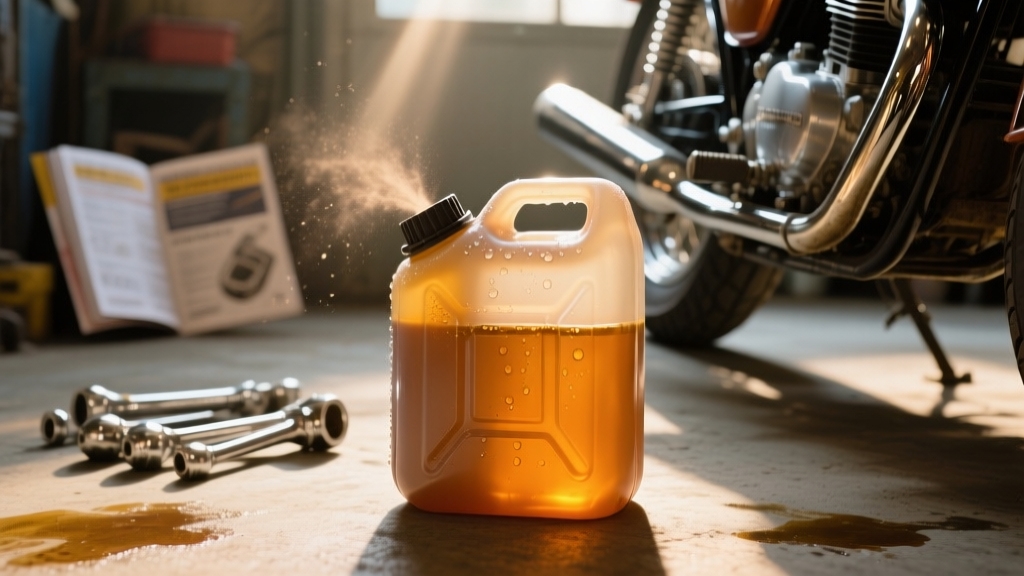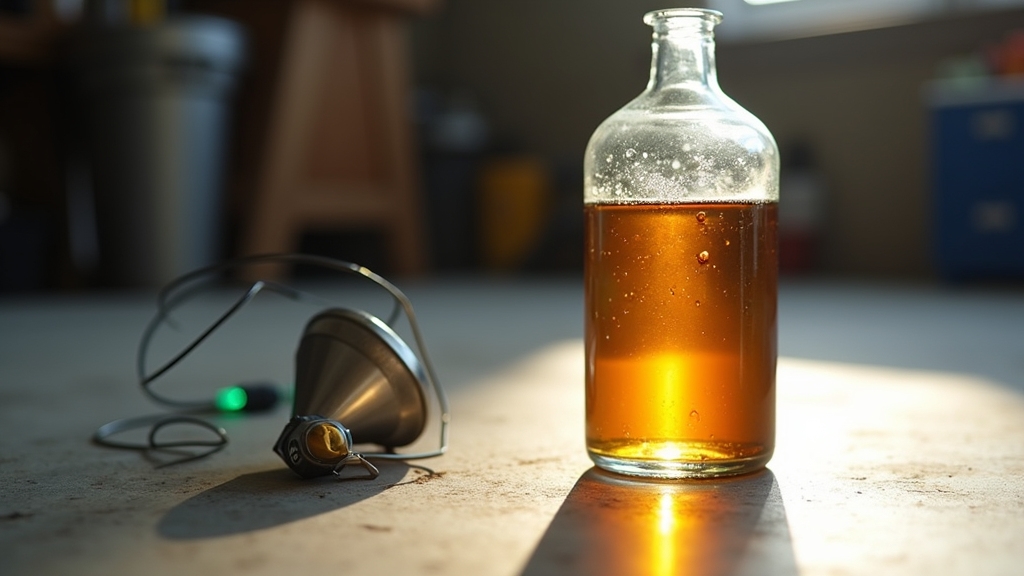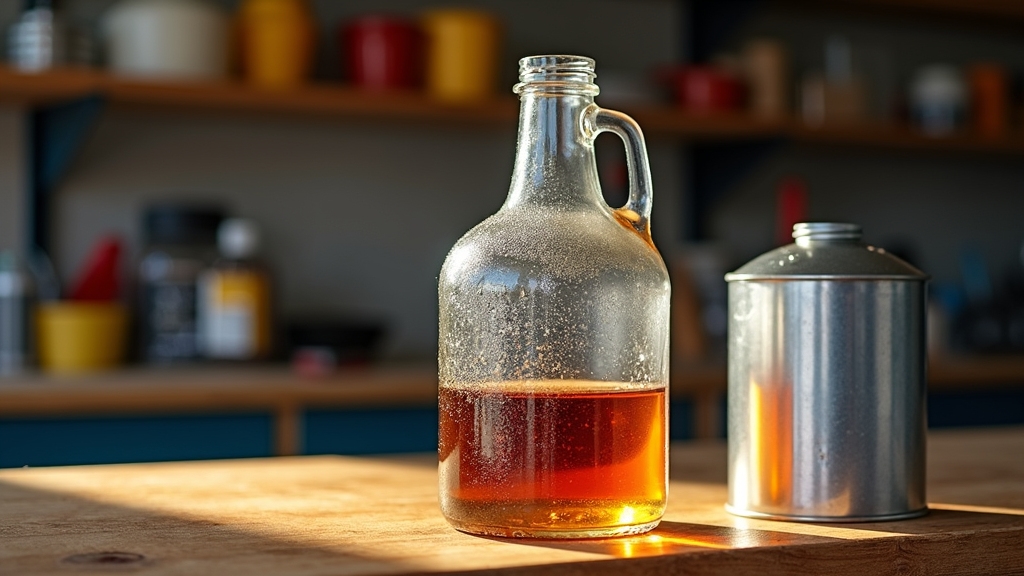Physical Address
304 North Cardinal St.
Dorchester Center, MA 02124
Physical Address
304 North Cardinal St.
Dorchester Center, MA 02124

You can expect ethanol-free gasoline to last about six months when stored properly in airtight containers below 60°F, minimizing oxygen and moisture exposure. Using fuel stabilizers can extend its usable life up to a year or more by preventing oxidation and corrosion.
Poor storage conditions accelerate degradation, leading to gum formation and engine issues. To maximize fuel quality and engine performance, it’s helpful to understand the factors influencing fuel longevity and best storage practices.

Although ethanol-free gasoline generally offers better stability, its shelf life depends substantially on storage conditions.
Ethanol-free gasoline typically lasts longer, but proper storage is key to maintaining its stability.
When stored ideally in airtight, approved containers kept below 60°F (15°C) in cool, shaded, and dry environments, ethanol-free gas can last up to six months without significant degradation. Proper storage also minimizes the risk of contamination that can affect fuel quality and engine performance.
Some stabilized ethanol-free fuels extend this to 1–5 years unopened and about two years once opened.
Proper containers, such as metal or high-quality plastics with effective seals, prevent oxygen and moisture ingress, which otherwise accelerate oxidation and evaporation.
Because ethanol is absent, ethanol-free gasoline does not attract water or cause fuel separation, which helps maintain fuel quality longer.
Without stabilizers, untreated ethanol-free gasoline may still remain usable for over a year if stored well.
However, even under perfect conditions, fresh fuel is recommended for seasonal use to maintain best engine performance and avoid issues from oxidation-related gum and sludge formation. Additionally, using the right fuel additives can help extend shelf life and protect engine components.
Because ethanol-free fuel naturally resists some forms of degradation, its longevity still depends heavily on several essential factors.
Oxygen exposure accelerates oxidation, forming gums and varnishes that degrade fuel quality. You’ll want to minimize air space and avoid frequent container openings. Proper alignment of storage containers can further reduce exposure to air and contaminants.
Water contamination, primarily from condensation or leaks, promotes rust and engine damage. Maintaining sealed, dry storage environments reduces this risk. Ethanol-free gasoline benefits from reduced water absorption compared to ethanol blends, but moisture can still cause issues if not controlled.
Temperature plays a key role; higher heat speeds evaporation and chemical breakdown. Storing fuel in cool, shaded areas is vital. Ideally, fuel should be stored below 60°F (15°C) to slow degradation caused by temperature fluctuations.
Additionally, compatible fuel additives and stabilizers can extend usability by preventing oxidation and moisture absorption without introducing alcohols.
Finally, container type and handling affect fuel integrity. Use airtight, fuel-grade containers, keep them sealed and clean, and rotate fuel every few months to avoid degradation. Metal or high-quality plastic containers are preferred to minimize chemical reactions that can accelerate fuel breakdown.

When it comes to storing ethanol-free gasoline, you’ll want to keep a few key things in mind. First, find a cool, dry, and well-ventilated spot that’s away from direct sunlight and any heat sources. This helps prevent the fuel from breaking down and reduces fire risks. Proper storage also helps avoid issues such as fuel contamination.
Next, make sure you use approved, airtight containers. This is super important because it minimizes evaporation and keeps contaminants out. Oh, and when you fill those containers, aim to fill them about 95% full. This little tip is great for accommodating fuel expansion.
If you plan on storing the gasoline for more than three to four months, consider adding a fuel stabilizer. It really helps extend the shelf life by preventing oxidation and gum formation. Additionally, you should label containers with the purchase date to keep track of the fuel’s freshness.
When storing ethanol-free gasoline, maintaining a cool, dry environment with stable temperatures below 80°F (27°C) considerably slows fuel degradation and evaporation. Proper storage can also help preserve the fuel’s performance characteristics over time.
Keep your fuel containers out of direct sunlight and away from heat sources, sparks, or open flames to reduce chemical breakdown and fire risk.
Use only approved, airtight containers such as HDPE or metal safety cans, sealing them tightly to prevent moisture and air intrusion. Avoid overfilling; leave about 5% headspace for expansion.
Store containers off the ground on shelves or pallets in a well-ventilated area to prevent vapor accumulation and contamination. This also helps reduce risk, supporting emergency preparedness with reliable fuel supply.
Label containers with purchase dates to facilitate rotation. For equipment tanks, keep them full and sealed tightly to minimize air exposure and moisture ingress, which can cause corrosion.
Proper storage conditions help slow fuel degradation, but additional measures are necessary to extend ethanol-free gasoline’s usability. Liqui Moly’s unique stickiness for effective lubrication in cold conditions highlights the importance of cold start behavior in fuel management.
You should add fuel stabilizers, glycol or petroleum-based, to fresh gasoline before storage to inhibit oxidation and preserve volatile components.
Always follow the manufacturer’s dosage instructions to avoid reduced effectiveness.
Add stabilizer to a nearly full tank to minimize air exposure, then mix thoroughly by shaking the container or briefly running the engine. This is important because ethanol-free gasoline does not attract moisture like ethanol blends, reducing the risk of water contamination.
Additionally, using high-quality additives similar to those in premium engine oils can enhance fuel stability over time. Label containers with treatment dates for monitoring.
Periodically inspect fuel for cloudiness or sediment and run equipment monthly to circulate stabilized fuel, preventing gum and varnish buildup.
These best practices can extend ethanol-free gasoline’s shelf life up to 6–12 months, considerably reducing the risk of fuel system damage caused by oxidation and evaporation.
Although both ethanol-free gasoline and ethanol-blended fuels serve as common options for powering engines, they differ substantially in chemical stability, storage longevity, and effects on equipment.
Ethanol-free gas resists water absorption, reducing corrosion and phase separation risks. It can last about six months when stored properly, with stabilized pre-packaged versions extending shelf life further. This longer shelf life is especially ideal for storage of vehicles, boats, and equipment. Additionally, ethanol-free fuel aligns better with engines requiring corrosion inhibitors to maintain system integrity over time.
In contrast, ethanol blends typically degrade within three months due to oxidation, evaporation, and moisture uptake. Ethanol’s hygroscopic nature accelerates rust and damages rubber components, especially in older or small engines. Ethanol-free fuel minimizes such wear.
Both fuel types benefit from cool, dry, airtight storage. However, ethanol blends require more frequent maintenance to manage water and sludge buildup. Your choice depends on equipment compatibility, cost, and intended storage duration.
Since fuel degradation directly affects combustion quality, you’ll notice a decline in engine performance over time.
As ethanol-free gas oxidizes, its octane rating drops, making ignition harder and causing sluggish acceleration and engine hesitation.
Deposits of gum and varnish restrict fuel flow, reducing combustion efficiency and leading to uneven firing and misfires. Regular inspection and cleaning of the fuel system can help mitigate these issues by maintaining fuel quality.
Contaminants like water and particulates worsen the problem by causing emulsions and clogging injectors, which increases engine roughness and stalling risk.
Reduced combustion efficiency raises fuel consumption and emissions while decreasing horsepower and drivability.
Additionally, degraded fuel accelerates corrosion and wear in fuel system components, fouling injectors and valves, which further impairs engine sealing and compression.
These contaminants also cling to and damage engine parts, increasing friction and wear over time, which shortens the engine’s lifespan engine wear. Proper storage conditions and fuel polishing techniques can extend fuel usability and protect engine components.
When you add fuel stabilizers to ethanol-free gas, you substantially slow down oxidation and degradation processes, extending the fuel’s effective shelf life well beyond its natural stability.
Stabilizers preserve fuel quality for months, even up to a year, by preventing varnish, gum deposits, and oxidation byproducts. They also contain corrosion inhibitors, forming a protective film on metal components to reduce rust and degradation inside fuel systems.
Choosing the correct viscosity rating of gear oil is similarly crucial for protecting mechanical parts under different temperature conditions. Though ethanol-free gas resists phase separation, stabilizers help bind trace moisture, preventing microbial growth and water-induced spoilage.
This maintains combustion efficiency and engine reliability during storage. Many boat owners add additives like Ring Free and PRI-G regardless of fuel type as a form of preventive measure.
Additionally, stabilizers improve cold-start performance by preserving volatile compounds and preventing fuel line clogging. Using them reduces maintenance costs and fuel wastage, providing a cost-effective way to preserve fuel integrity and protect your engine over prolonged storage periods.
Because ethanol-free gasoline resists many common degradation pathways seen in ethanol blends, you might expect it to remain stable indefinitely; however, user experiences and industry data highlight that its effective shelf life generally caps at around six months under typical storage conditions.
Most small engine users rotate their ethanol-free fuel every 4–6 months to avoid oxidation and performance loss. While some says longer storage up to a year, these cases often involve ideal, stable temperatures and sealed metal containers.
Rotate ethanol-free fuel every 4–6 months to prevent oxidation and maintain performance under typical conditions.
Industry experts agree ethanol-free gas degrades slower than E10 but still undergoes oxidation, evaporation, and contamination risks. Visual cues like discoloration or sediment, along with engine issues, signal fuel degradation.
Despite ethanol-free fuel’s advantages, prudent storage and timely use remain essential to maintain optimal engine performance.
Additionally, using motor oils with advanced additive technology can help mitigate engine wear caused by degraded fuel.
Although ethanol-free gas resists many common degradation issues, you still need to manage its storage carefully to maintain fuel quality. Proper storage conditions, such as keeping containers in a stable temperature range, are crucial to prevent chemical breakdown and contamination.
Store fuel in small, 1-5 gallon containers labeled with the purchase date to track age accurately. This practice supports effective inventory management and helps ensure fuel is used before it degrades.
Keep containers sealed tightly in a dry, temperature-controlled environment to prevent moisture exposure and temperature-induced degradation.
Rotate your fuel supply every few months, using the oldest first, to ensure freshness and prevent performance loss. Rotating stored fuel every 4-5 months helps maintain usability.
If you plan to store fuel beyond six months, add a fuel stabilizer designed for ethanol-free gas to extend its shelf life. Regularly inspect containers for signs of contamination or fuel breakdown.
Following these practices will preserve fuel integrity, optimize engine performance, and reduce maintenance issues associated with degraded fuel.
You can’t use ethanol-free gasoline in all engines.
It’s crucial for small engines, classic cars, and specialty engines that are sensitive to ethanol’s corrosive effects.
However, most modern vehicles designed for ethanol blends up to E10 won’t benefit considerably from ethanol-free gas and might find it harder to source.
Always check your engine manufacturer’s recommendations before choosing ethanol-free fuel to guarantee compatibility and peak performance.
Think of ethanol-free gas like a liquid sunbeam. When temperatures rise, it dances away faster.
You’ll notice that higher heat increases the evaporation rate markedly, as molecules gain energy and escape into the air.
At elevated temperatures, vapor pressure climbs, speeding up loss through evaporation.
So, if you store your fuel in warm conditions, expect quicker evaporation.
Keeping it cool slows this process, preserving fuel quality longer.
Yes, you’ll find TruFuel stands out for longer-lasting ethanol-free fuel, thanks to its integrated stabilizers offering up to five years unopened and two years after opening.
Ricochet Fuel Distributors also provides stable ethanol-free options with additives that reduce engine wear.
For race or marine applications, brands with proprietary stabilizers and higher octane ratings generally maintain fuel integrity longer.
Always store fuel sealed, cool, and dry to maximize these benefits.
When disposing of old ethanol-free gas, you should never pour it into drains or water bodies.
Store it in approved, labeled containers away from heat or sparks.
Always handle fuel in well-ventilated areas using gloves and goggles to avoid inhalation or skin contact.
Transport containers securely and use funnels to prevent spills.
Dispose only at designated hazardous waste centers, informing staff about the fuel type to guarantee proper treatment and compliance with local regulations.
Yes, ethanol-free gasoline has a distinct smell and color compared to regular gas.
You’ll notice it often smells different due to the absence of ethanol, which changes the odor profile.
Visually, it tends to be slightly darker or more amber than regular gasoline, which usually appears clear or faintly yellow.
These differences stem from the ethanol additive’s absence and variations in fuel formulation and additives.
When you store ethanol-free gasoline properly, it tends to stay reliable longer than its ethanol-blended counterparts. This gives your engines a smoother ride over time. Keep in mind that even the best-kept fuel eventually reaches its twilight. Rotating your supply and using stabilizers can gently extend its prime.
By understanding these subtle nuances, you guarantee your fuel remains a trustworthy companion. This helps avoid unexpected hiccups and maintains ideal performance throughout its lifespan.